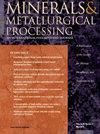Acid mine drainage remediation strategies: A review on migration and source controls
Q2 Materials Science
引用次数: 25
Abstract
Acid mine drainage (AMD) derives from the oxidation of sulfide minerals, primarily pyrite (FeS2), and is the most severe environmental issue facing the minerals industry. The most common short-term approach to AMD treatment is migration control, such as acid neutralization and metal/metalloid and sulfate removal, through the addition of alkaline materials, including lime (Ca (OH)2), limestone (Ca CO3), gangue minerals and industrial wastes. This requires the continuous input of materials and may result in the production of a vast amount of secondary sludge requiring further treatment and disposal. Addition of chemicals is usually more important in metal/metalloid removal than in sulfate removal unless the sulfate is present in very high concentrations. A more promising long-term strategy for AMD prevention is source control through the complete removal of pyritic minerals and encapsulation of potential risk minerals by coating with impermeable surface layers. This is regarded as the most cost-effective approach, although the mechanisms underpinning this and the implementation procedures are yet to be fully elucidated. It is likely that long- and short-term practices can be combined to optimize the remediation of contaminated mining sites. Some factors such as differing geological and mineralogical characteristics and transportation costs must also be considered for the successful implementation of AMD prevention and remediation strategies. This review also considers some implications for AMD remediation, but the promising bioremediation of AMD is not discussed as it has been extensively reviewed.酸性矿山排水修复策略:迁移和源头控制综述
酸性矿山废水(AMD)是由硫化物矿物氧化产生的,主要是黄铁矿(FeS2),是矿业面临的最严重的环境问题。AMD最常见的短期治疗方法是通过添加碱性物质,包括石灰(Ca (OH)2)、石灰石(Ca CO3)、脉石矿物和工业废物,来控制迁移,如酸中和和金属/类金属和硫酸盐的去除。这需要不断投入材料,并可能导致产生大量需要进一步处理和处置的二次污泥。在去除金属/类金属时,添加化学品通常比去除硫酸盐时更重要,除非硫酸盐的浓度非常高。预防AMD的一个更有希望的长期策略是通过完全去除黄铁矿和用不透水的表面层包裹潜在危险矿物来控制源头。这被认为是最具成本效益的办法,尽管支持这一办法的机制和执行程序还有待充分阐明。很可能将长期和短期做法结合起来,以优化对受污染矿区的补救。要成功实施AMD的预防和修复策略,还必须考虑不同的地质和矿物学特征以及运输成本等因素。这篇综述也考虑了AMD修复的一些意义,但由于AMD的生物修复已经被广泛讨论,所以没有讨论它的前景。
本文章由计算机程序翻译,如有差异,请以英文原文为准。
求助全文
约1分钟内获得全文
求助全文
来源期刊

Minerals & Metallurgical Processing
工程技术-矿业与矿物加工
CiteScore
0.84
自引率
0.00%
发文量
0
审稿时长
>12 weeks
期刊介绍:
For over twenty-five years, M&MP has been your source for the newest thinking in the processing of minerals and metals. We cover the latest developments in a wide range of applicable disciplines, from metallurgy to computer science to environmental engineering. Our authors, experts from industry, academia and the government, present state-of-the-art research from around the globe.
 求助内容:
求助内容: 应助结果提醒方式:
应助结果提醒方式:


